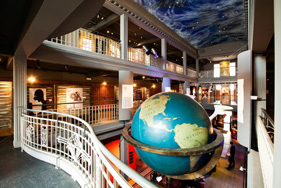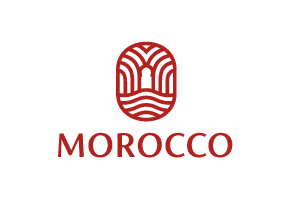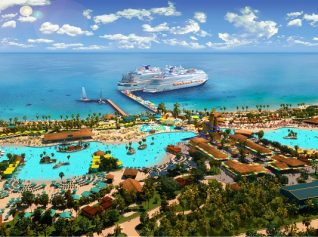Nine European historical sites now on the European Heritage Label list

Mundaneum
Now 20 sites have received label
The sites are: The Neanderthal Prehistoric site and Krapina Museum (HR), the Olomouc Premyslid Castle and Archdiocesan Museum (CZ), the Sagres Promontory (PT), the Imperial Palace (AT), the Historic Ensemble of the University of Tartu (EE), Liszt Ferenc Academy of Music (HU), Mundaneum (BE), WWI Eastern Front Cemetery N°123 (PL) and the European District of Strasbourg (FR).
Now 20 sites have received the Label in the past two years.
This year’s sites are:
Krapina Neanderthal Site (Krapina, Croatia)
In 1899 at this site were found the largest number of Neanderthal fossil bones in Europe, some nine hundred human remains from about eighty individuals, as well as bones of various animals dating back 125 000 BC. Experts from all over the world have conducted research on the collection and their interpretation of the Krapina findings influenced different scientific theories about human development, the genesis of our civilisation and about how human communities in Europe lived during the Pleistocene period.
Next to the archaeological site, the Krapina Neanderthal Museum presents today and in an interactive way the origin of life on Earth and the evolution of humankind.
Olomouc Premyslid Castle and Archdiocesan Museum (Olomouc, Czech Republic)
The Archdiocesan Museum is devoted to the conservation of works of art of the Olomouc Archdiocese. Its collections are shown in the Chapter Deanery at the Premyslid Castle, a location representing thousand years of history, from the remnants of the Bishop’s and Prince’s Palaces to Baroque and Rococo.
The Olomouc Premyslid Castle and Archdiocesan Museum are a focal point of Moravian presence in European history. It is an early centre of Christianity, a place that preserves and highlights the high level of artistic patronage of the archbishops of Moravia, and a fine example of heritage conservation in the region.
Sagres Promontory (Portugal)
The Sagres Promontory is a rich cultural and historical landscape located at the south-west corner of the Iberian Peninsula. It comprises a series of significant archaeological remains, urban structures, and monuments testifying its strategic location and importance over the centuries.
The Promontory became the headquarters of Prince Henry the Navigator for his projects of maritime expansion during the fifteen century, a key location of the Age of Discoveries that marked the expansion of European culture, science, exploration and commerce both towards the Atlantic and the Mediterranean, setting European civilisation on its path to the global projection that came to define the modern world.
The Imperial Palace (Vienna, Austria)
Initiated in 1240, the Imperial Palace is a complex of buildings and gardens which used to serve as the residence of the Habsburgs, a ruling family of large parts of Europe during some 700 years. The Habsburg Empire was a multi-ethnical and a multi-religious empire that had a strong political, administrative, social and economic impact on territories that include or are part of today’s Austria, Hungary, Czech Republic, Poland, Slovenia, … Today, the Imperial Palace is home to the seat of the Austrian Federal President, five world-class museum organisations as well as other cultural institutions.
Historic Ensemble of the University of Tartu (Tartu, Estonia)
The historic ensemble of the University of Tartu is a campus designed at the beginning of the nineteenth century under the motto "A university in the city, a university in the park". It embodies the ideas of a university in the Age of Enlightenment. Linking science and learning and reflects the European tradition in education.
Established in 1632 by the Swedish King Gustav II Adolf, and though it changed hands between the various political powers in the region including Sweden, Poland, Germany, Russia, the Soviet Union and Estonia, Tartu University has always remained a beacon of progressive ideas.
Liszt Ferenc Academy of Music (Budapest, Hungary)
The Liszt Ferenc Academy of Music was established in 1875 by the outstanding composer and musician himself. It is a multi-faceted institution: an educational institution, an international university of musical arts and a concert centre. It brings our music heritage to the fore whilst holding true to its spirit of openness, creativity and innovation and its European and international character.
The Academy is housed in a 1907 building by Flóris Korb and Klman Giergl, which is considered to be a masterpiece of Hungarian Secession. It integrates inter alia the Liszt Ferenc Memorial Museum and Research Centre, the Kodly Institute and the Kodly Museum.
Mundaneum (Mons, Belgium)
The Mundaneum is a landmark in the intellectual and social fabric of Europe. Its founders, Henri La Fontaine and Paul Otlet, were advocates of peace through dialogue and sharing knowledge at European and international level with the means of bibliographic enquiry. The Mundaneum’s aim was to gather all information available in the world, regardless of its medium (books, newspapers, postcards…), and to classify it according to a system they developed, the Universal Decimal Classification.
The Mundaneum provide the foundations of present-day information science and is considered today as precursors of internet search engines.
World War I Eastern Front Cemetery No. 123 (-u-¼na – Pustki, Poland)
Wartime cemetery No 123, established in 1918 on the Pustki hill is the scene of one of the largest battles of World War I on the Eastern front between the Austro-Hungarian and German armies and the Russian Army: the battle of Gorlice, also called the Verdun of the East. The cemetery is the final resting place for soldiers from these three armed forces, coming from territories that are part of today’s Austria, Hungary, Germany, Poland, Ukraine, Russia, Slovenia,.. and from different religious and linguistic backgrounds.
The World War I Eastern Front Cemetery No 123 is a place of remembrance embodying the idea of ecumenism, with its identical treatment of the fallen, regardless of their military, ethnic or religious affiliation.
European District of Strasbourg (Strasbourg, France)
Since its creation after the Second World War, the European District of Strasbourg is the home to the Council of Europe, its European Court of Human Rights and the European Parliament of the European Union. It bears witness to European integration, the defence of human rights, democracy and the rule of law.
Further information HERE
Valere Tjolle
New industry Italy green guide out: HERE
Green masterclasses series unveiled for autumn: HERE
Green tourism battle lines are being drawn: HERE
 United Kingdom
United Kingdom United States
United States Asia Pacific
Asia Pacific












































BA suspending all Heathrow to Abu Dhabi flights
Unexpected wave rocks cruise ship
Report: Cruise guest died after ship lashed in heavy storm
British teen in serious condition after paraglider collision
JetBlue scraps London Gatwick flights